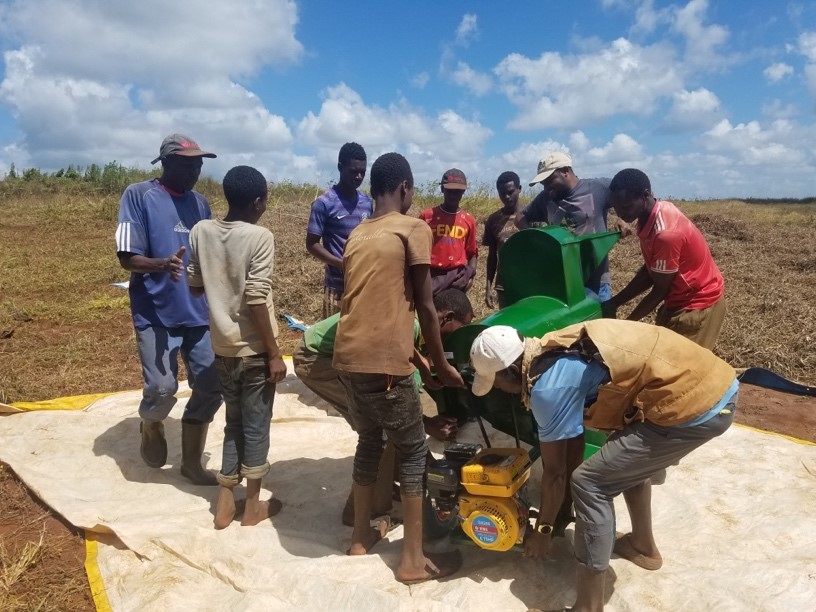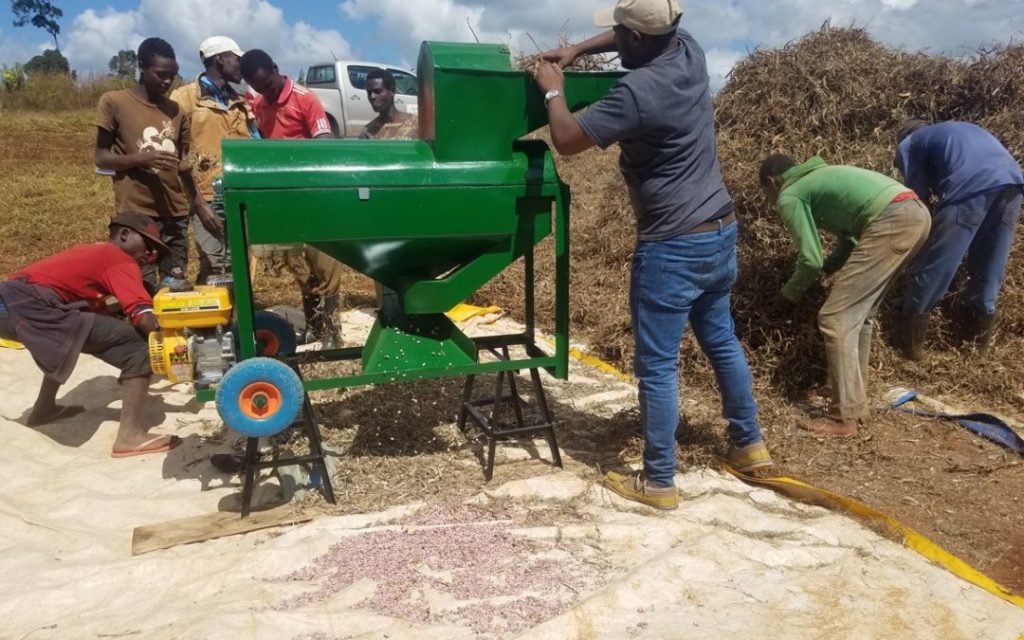Authors: Ramya Kulkarni (CRP-GLDC MEL Team) and Jean Claude Rubyogo, Leader, Flagship Program 6: Common Bean for Markets and Nutrition
For reduced market barriers, diversified enterprise and livelihood opportunities.
How are youth being gainfully employed as mechanization service providers in the African region?
About one-third of Africa’s nearly 500 million youth aged 15-35 are unemployed. The high rate of youth unemployment remains a critical concern for governments as it results in poor living conditions. This can prove a key driver for migration, may trigger insecurity and even political instability. Yet, youth being Africa’s greatest asset, offer a dynamic workforce that is innovative, appetite for a high uptake of modern technological know-how, and ability to take on significant levels of risk.
In Tanzania, although two thirds of the workforce depend on agriculture for their livelihoods, most farms are still reliant on unproductive manual farming methods. With an increase in the number of young people migrating in search of better opportunities and to escape manual farming, their future with farming as a livelihood is increasingly becoming unattractive.
To address such concerns, mechanisation of small farms can create many employment opportunities while increasing agricultural productivity and income. In 2019, the Alliance for Bioversity International (Bioversity International) & the International Centre for Tropical Agriculture (The Alliance) and the Tanzania Agriculture Research Institute (TARI), both members of the Pan-Africa Bean Research Alliance (PABRA-Africa), in collaboration with Soybean Innovation Lab of Missouri State University trained local artisans on manufacturing Multi-Crop Threshers (MCT) in Tanzania.
What challenges does this innovation address?
Every year, Tanzanian smallholder farmers invest around 1.35 billion hours and US$ 28/ton to manually thresh their crops. What would it mean to those farmers if they can save 1.2 billion hours from this farming activity, while spending only US$ 15/ton? Post successful completion, one such training by PABRA, Imara Tech, a youth-owned company based in Arusha, upgraded their prototype from one crop to a MCT that threshes up to eight staple grains including beans. MCT saves time and maintains grain quality (free from breakage and impurities compared to the hand threshing method or by tractor), is portable and can be carried on a motorcycle, from farm-to-farm offering services during harvest season.
This approach is operationalized by employing youth as service providers that aim to eliminate bottlenecks in the bean value chain including reduction of market barriers, diversify enterprise opportunities, increase livelihood opportunities, reduce pre- and post-harvest losses. Besides enhancing the availability of diverse nutrient-rich foods. This innovation contributes to SDG 1 “To end poverty in all its forms, everywhere”, SDG 2 “End hunger, “achieve food security and improved nutrition and promote sustainable agriculture, SDG 5 “Achieve gender equality and empower all women and girls”, and SDG 8 “Promote sustained, inclusive and sustainable economic growth, full and productive employment and decent work for all”.
Results achieved through this innovation
When launched in 2019, Imara Tech’s primary location of implementation was Arusha in Tanzania. Since 2020, the geographic scope of impact has further spread across Tanzania, Burundi, Ethiopia, Zambia, Zimbabwe, Kenya, and Uganda.
In the two years since fabricating the MCT, Imara Tech has manufactured and sold 420 units in 17 Tanzanian districts, 10 units in Uganda, and one in Burundi, thereby making a profit of US$ 297,960 (Tsh. 688,000,000) with 20 agents including seven women in three regions of Arusha, Kilimanjaro, and Manyara.
With recognition and funding from agencies, 49 local artisans (10 are permanent employees and 39 are outsourced in the busiest season) have been trained in the fabrication of MCTs. Hard to reach farmers are now accessible to these youth owners who carry Imara Tech’s portable MCTs to provide threshing services during harvest season while earning incomes of up to US$ 5.3 /hr (US$ 19.50/ton) by providing threshing services. In 8,850 smallholder farms served by MCT in 2020 alone, women and children who used to do manual threshing, now have time for other activities and attend schools, respectively.
Partners and funders of this Innovation
Through the partnerships created by PABRA, the Alliance of Bioversity International – CIAT, TARI and Soybean Innovation, Imara Tech was able to gain momentum and grow exponentially. Other partner and funding agencies supporting PABRA/the Alliance include the Tropical Legume III Project supported by the Bill and Mellinda Gates Foundation (BMGF), Improving Bean Productivity and Marketing in Africa Project supported by Global Affairs Canada (GAC), Swiss Agency for Development & Corporation (SDC), United States Agency for International Development (USAID) and the CGIAR Research Program on Grain Legumes and Dry Land Cereals (CRP-GLDC).
Next steps to scale this Innovation
As a Stage 4 and a Maturity level 3 innovation, these businesses have been taken up by users through market-based solutions and are contributing to poverty reduction, livelihoods and jobs, gender equality, and youth and social inclusion. Policy and/or practice changes influenced by these innovative business models have led to adoption or impacts at scale or beyond the direct CGIAR sphere of influence. Among others, this is evidenced by adoption and use of the MCT that has significantly contributed towards closing the gender gap in farm activities, particularly in bean production. A prominent hallmark of the MCT is economic empowerment through the creation of business opportunities including the provision of services that creates a direct source of income for young entrepreneurs. Since each thresher requires three workers – to feed the thresher with pods, to control the thresher and to direct the straw, it also provides new opportunities for job creation. Hence, the multiplier effect of this intervention is huge in terms of increased household income, reduction of drudgery for women farmers, and access to education amongst others.
References:
- https://www.imaratech.co/
- https://www.pabra-africa.org/youth-economic-empowerment-through-mechanization-in-tanzania/
- https://www.pabra-africa.org/
Acknowledgment: This work was undertaken as part of, and funded by the CGIAR Research Program on Grain Legumes and Dryland Cereals (CRP-GLDC) and supported by CGIAR Fund Donors.
This blog was first published at http://gldc.cgiar.org/


